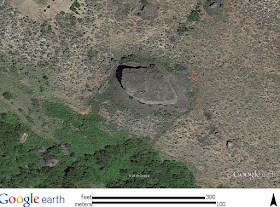My drilling oversite days have been limited over the past few years. I would say I am even a bit rusty at the job in that my skills of of opening sample tubes and putting them back together and using some of the tools was a bit awkward.
The project was to collect geotechnical data including assessing the the potential for soil liquefaction during a seismic event. Having done a bot of historic research as well as what I knew of the geology combined with the data needs, I went with a mud rotary drilling approach.
The set up starts by digging a shallow pit and punching a hole through a bag of bentonite clay chips. Na-bentonite expands when wet and hence is an excellent sealant.
The mud tub is placed over the hole in this case.
Clay is added and mixed with water to form the drilling mud. If this was a deeper boring (our scheme was to drill to 50 feet), a lot more mud would be needed. Drilling mud keeps oil and gas field drilling crews busy.
The actual drill is a tri-cone bit. We started with a used one as at least initially we had pretty easy drilling. Hard drilling some times carries a higher per foot charge as the ware on the expensive brill bits is a cost to the drillers.
The drill bit is attached to drilling rods and drilling begins with the mud circulated through the drill and back up into the tub. The mud spills onto a screen which captures bits of rock which are scraped off into a bucket by the driller helper with the rest of the mud being recycled into the system.
One can get an idea of the material encountered by inspecting the screen or grabbing some of the cuttings in the mud. In the picture below it was clear we were drilling through some wood.
Typically every five feet the drill is pulled up out of the hole and a sampler is attached to the drill rods. The sampler is then lowered to the bottom of the hole and driven by a hammer on the top of the rods into the subsurface ahead of where the drill had been. The mud keeps the hole open and in this case needs to also be thick enough to not leak out into the formation. Sometimes that is not possible if the formation is very coarse grained. In that event casing needs to be driven. In our case we were lucky and did not need to case the well - a time consuming process to be done right and not get the casings stuck.
The advantage of the mud approach is it prevents the sand we were drilling into from surging into the hole when the drill is pulled out for sampling. A big deal when one needs to get accurate in-place undisturbed soil compactness. The compactness can be estimated by counting how many hammer blows it takes to drive the sampler into the soil. If the soil is soft, the blow counts will be low, if compact the blow counts will be high. getting accurate blow counts is a big deal for assessing potential soil liquefaction.
After the sampler is pulled up, it is handed to the drilling logger (very often a geologist) and opened up and inspected on site and then collected for further assessment back in the office/lab.
In our case we were drilling into some very old beach deposits with periodic clam shells. This shell came from a depth of 30 feet - nearly 20 feet below the current beach level.
At about 40 feet the drilling encountered hard compact silt with pebbles (see below). We also drilled through a 4-foot diameter granite boulder. I interpreted the hard silt with pebbles and boulders as being an older glacial drift based on stratigraphy of the area.























